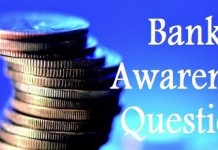Hello Aspirants. Welcome to Banking Awareness Quiz in AffairsCloud.com. Here we are creating quiz covering important questions which are common for all the bank exams and other competitive exams.
- What is the meaning of Lock period in Term deposit?
A. Customer cannot open another account
B. Nominee name need not be written
C. Pre-maturity is not possible
D. Locker must be opened by the customer in the branchC. Pre-maturity is not possible
Explanation:Term deposits are a fixed term investment which means that your money is ‘locked away’ until the end of the term when it reaches maturity. Term deposits come with a fixed rate as opposed to a variable interest rate, and are designed to be left in the account until the end of the term, which means if you need to close the account early or you want to access your money before the term ends, you will be charged a fee. - It is the market which expects the prices of shares rise in the market.
A. Fundamental market
B. Bull market
C. Bear Market
D. Depressed marketB. Bull market
Explanation:In a bull market, investors are positive. The economy tends to be strong. Unemployment is low. Consumers are spending money, which increases business profits. - Which of the following is false about Carbon Credit?
A. Tradable certificate
B. Right of an Industry to emit certain quantity of Carbon Dioxide
C. Carbon Credits mechanism was formalized in Kyoto Protocol
D. NoneD. None
Explanation:A carbon credit (often called a carbon offset) is a financial instrument that represents a tonne of carbon dioxide or carbon dioxide equivalent gases removed or reduced from the atmosphere from an emission reduction project, which can be used, by governments, industry or private individuals to offset damaging carbon emissions that they are generating. - MTSS stands for
A. Money Transfer Scheme for Service
B. Medium Transfer Service Strategy
C. Minimum Transfer Service Scheme
D. Money Transfer Service SchemeD. Money Transfer Service Scheme
Explanation:Money Transfer Service Scheme (MTSS) is a quick and easy way of transferring personal remittances from abroad to beneficiaries in India. Only inward personal remittances into India such as remittances towards family maintenance and remittances favouring foreign tourists visiting India are permissible. - The first RRB named Prathama Grameen Bank was started by ______.
A. Punjab National Bank
B. State Bank of India
C. Syndicate Bank
D. Canara BankC. Syndicate Bank
Explanation:The development process of RRBs started on 2 October 1975 with the forming of the first RRB, the Prathama Bank. Also on 2 October 1976 five regional rural banks were set up with a total authorised capital of Rs.100 crore which later augmented to 500 crore. RRBs were owned by the Central Government, the State Government and the Sponsor Bank(There were five commercial banks, Punjab National Bank, State Bank of India, Syndicate Bank, United Bank of India and United Commercial Bank, which sponsored the regional rural banks). - SWIFT stands for
A. Secure Window for Interbank Financial Transactions
B. Society Window In case of Financial Transaction
C. Society for Worldwide Interbank Financial Telecommunication
D. Secure Window Institute For TransactionsC. Society for Worldwide Interbank Financial Telecommunication
Explanation:Society for Worldwide Interbank Financial Telecommunication code. An internationally-recognized identification code for banks around the world. SWIFT codes are most commonly used for international wire transfers and are comprised of 8 or 11 alphanumeric characters. - Fiat money is defined as
A. Currency supported by Government Guarantee
B. Currency supported by tangible assets
C. Currency supported by gold reserves
D. Currency supported by budgetary supportA. Currency supported by Government Guarantee
Explanation:As valid currency solely by virtue of a government declaration, fiat money is not backed by any commodity, such as gold, but only by the faith of the bearer. In this respect, unlike currencies backed by gold or silver, fiat money does not have any intrinsic value (e.g., paper money and much coinage). The U.S. dollar is an example of fiat money. - Which among the following countries commenced first plastic notes?
A. China
B. America
C. Canada
D. AustraliaD. Australia
Explanation:Modern polymer banknotes were first developed by the Reserve Bank of Australia (RBA), Commonwealth Scientific and Industrial Research Organisation (CSIRO) and The University of Melbourne, first issued as currency in Australia in 1988. In 1996 Australia switched completely to polymer banknotes.
*Recent: Plastic banknotes that can survive a spin in the washing machine are to be brought into circulation by the Bank of England in 2016. - The movement that encouraged the foundation of commercial banks was ________.
A. Swadeshi movement
B. Quit India Movement
C. Non Cooperation Movement
D. Swadhar MovementA. Swadeshi movement
Explanation:Swadeshi movement, which began in 1906, encouraged the formation of a number of commercial banks. Banking crisis during 1913-1917 and failure of 588 banks in various parts of the country during the decade ended 1949 underlined the need for regulating and controlling commercial banks. The Banking Companies Act was passed in February 1949, which was subsequently amended to read as Banking Regulation Act, 1949. This Act provided the legal framework for regulation of the banking system in India. - The special drawing right granted by the International Monetary Fund to its member countries is _______________.
A. Cold money
B. Hot money
C. Soft money
D. Paper goldD. Paper gold
Explanation:International financing instrument created in 1970 by the International Monetary Fund (IMF) to coincide with the disfavor of the US dollar as the principal currency of the world trade. Also called paper gold, an SDR is neither paper nor gold but an accounting entry. It is not backed by any currency or precious metal, and is used only among governments and IMF for balance Of payments settlements.
AffairsCloud Recommends Oliveboard Mock Test
AffairsCloud Ebook - Support Us to Grow
Govt Jobs by Category
Bank Jobs Notification


